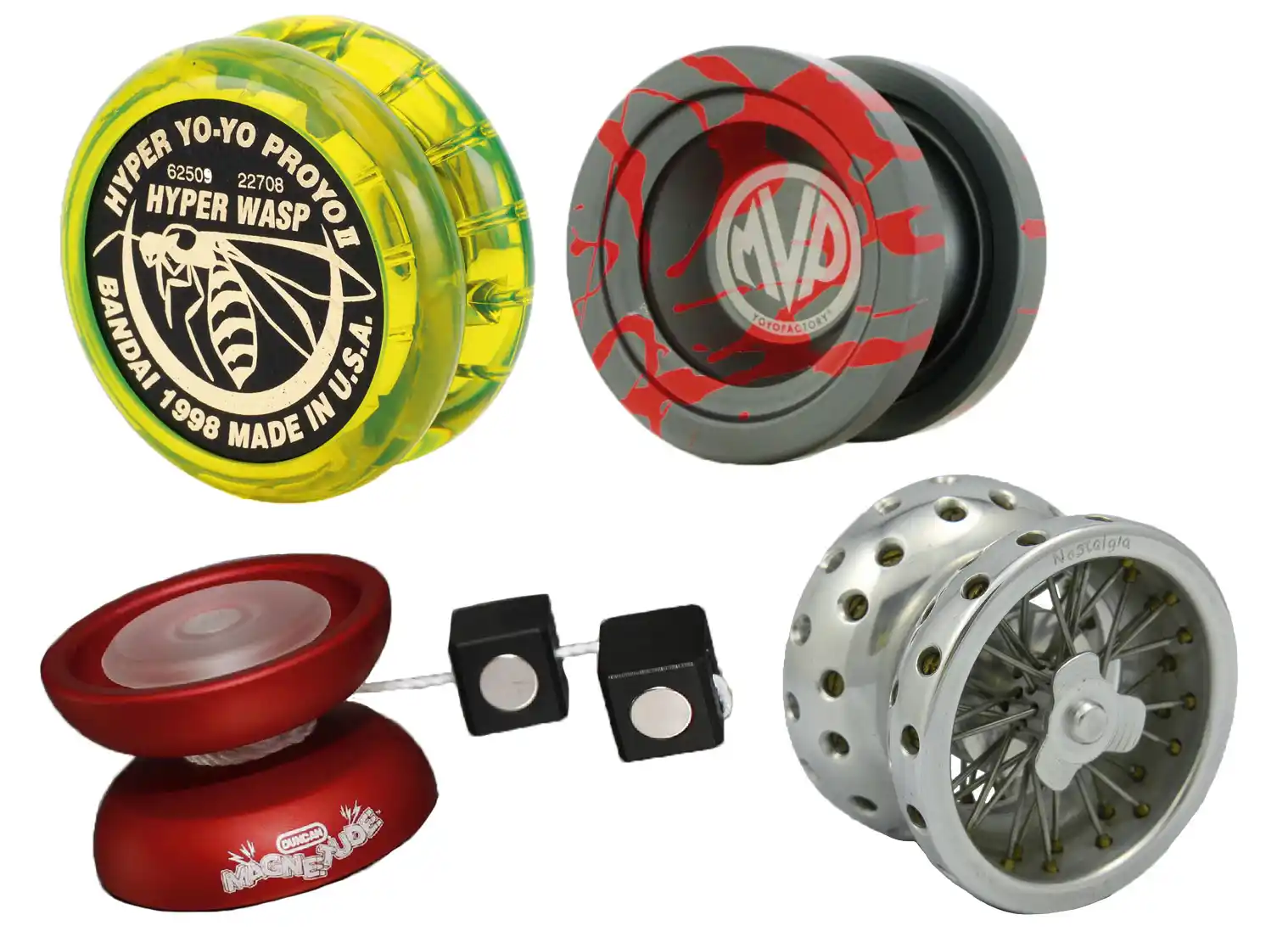Get ready to dive into the world of yoyos! We’ll unravel the secrets and fun facts that make this toy so special. From the first yoyo ever made to the cool brands of today, you’ll learn everything you ever wanted to know about this spinning wonder. So, get comfortable and let’s spin some knowledge!
Yo-Yo Facts
Okay, so you probably know yo-yos, right? Those little toys that go up and down on a string? They’ve been around for ages – we’re talking ancient history here. Imagine this: there’s a Greek vase from way back in 500 BCE with drawings of people using yo-yo-like objects. Historians suggest they might have used them for hunting, although it wasn’t all fun and games back then. Over time, though, these objects evolved, and by the 1700s, they were all the rage in Europe as toys.
Then came the 1920s, and a guy named Pedro Flores changed the game. He figured out the “loop-the-loop” trick, and suddenly, yo-yos were cooler than ever. Fast forward to the 1960s, and boom – plastic arrives! This meant you could make yo-yos that were way more advanced and could do even crazier tricks.
And speaking of tricks, did you know that yo-yoing is actually a competitive sport now? There are world championships and everything! These yo-yoers are like magicians, pulling off these gravity-defying routines that’ll make your jaw drop. They even took yo-yos to space – no joke! Astronauts wanted to see how zero gravity messed with their yo-yo skills.
But hey, yo-yos aren’t just for showing off. They’re also believed to be pretty good for you! Think hand-eye coordination, focus, and even relaxation. Plus, they’re like little science lessons in your hand, illustrating things like gravity and momentum.
Oh, and get this: the longest someone has ever kept a yo-yo spinning is over 40 minutes! That’s some serious dedication. And if you thought that was wild, there’s a yo-yo out there that’s bigger than a car – over 6 feet wide! They’ve even popped up in movies, TV shows, and video games.
So yeah, those little toys you might have played with as a kid? They’ve got a pretty fascinating history and a whole lot going on beneath the surface.
What is a Fun Fact About Yoyos?
Prepare to have your mind blown because we’re about to dive into some seriously cool trivia about yoyos! We’ve already talked about how awesome they are, but did you know that these little toys have a history that goes way, way back? Like, we’re talking ancient Greece kind of old! Archeologists have actually found images of yo-yo-like objects on pottery from around 500 BC. That means people may have been enjoying the simple pleasure of a spinning yo-yo for over two thousand years!
And get this – it wasn’t just the Greeks who were in on the fun. There’s evidence suggesting that ancient cultures all over the world, from China to the Philippines, had their own versions of yoyos. It seems like no matter where you go in history, people have always loved a toy that could go up and down on a string!
Now, you might be thinking, “Okay, that’s kinda neat, but it’s still just a toy, right?” Well, hold on to your hats because yoyos are more than meets the eye. In the 20th century, things really started to take off in the yo-yo world. People figured out how to do all sorts of amazing tricks, like the famous “loop-the-loop,” and suddenly, yo-yoing wasn’t just a way to pass the time – it was serious business!
Fast forward to today, and we’ve got competitive yo-yoing! That’s right, people battling it out with their best tricks and techniques, all vying for the title of yo-yo master. Who would have thought that this simple toy would evolve into such a complex and impressive sport?
But wait, there’s more! Yoyos have even gone where no toy has gone before – outer space! Astronauts have experimented with yoyos in zero gravity, and let’s just say the results are out of this world. Turns out, without gravity holding it down, a yo-yo can spin for a really, really long time!
So, there you have it – a fun fact about yoyos that might just leave you wanting more. Who knows what other secrets these spinning wonders hold? One thing’s for sure, the yo-yo’s journey through time is far from over!
How did the yoyo get its name?
So, we know this little toy has been making its way around the world for a while, but how did it get its catchy name? Well, if we fast-forward past ancient China and all the way to the 1920s, we find ourselves face-to-face with a man named Pedro Flores. Now, Pedro was a pretty smart cookie. He saw the potential of this “come-come” toy from his Filipino heritage and thought, “Hey, the world needs to experience this!” And guess what? He was right!
The word “yoyo” itself comes directly from the Filipino language, where it means, you guessed it, “come-come” or “to return.” It perfectly captures the essence of the toy, right? Pedro took this word, already infused with the spirit of the toy, and introduced it to the wider world.
Of course, language is a funny thing, and there are always other theories floating around. Some folks believe the word might have connections to other languages or cultures, and it’s certainly possible! Language has a way of intertwining and evolving over time. But for now, the most widely accepted theory points to Pedro Flores and the Filipino language as the source of the name we all know and love today.
Is the Yo-Yo the Oldest Toy in the World?
So, we’ve established that the yo-yo has been around for ages. But can we really call it the oldest toy in the world? Well, that’s tricky. Think of it like this: archaeologists are like history detectives, and they’ve found objects that look a lot like yo-yos in places like Greece, China, and even the Philippines. These finds go way back in time, suggesting people have been playing with yo-yo-like things for a really, really long time.
One compelling clue comes from ancient Greece – picture a beautifully painted vase from around 400-500 BC. On it, you see children playing with something that looks remarkably like a yo-yo! This discovery leads some experts to believe that Greece might be the birthplace of our favorite up-and-down toy. However, there is other evidence suggesting that China or the Philippines could also be contenders for the title of “Yo-Yo Hometown.”
The truth is, pinning down the yo-yo’s exact origin is like solving a puzzle with some pieces missing. Each new archaeological find, each ancient artwork, adds another piece to the puzzle, but we might never have the complete picture. And that’s okay! The mystery surrounding its origins just adds to the yo-yo’s charm. What we do know for sure is that this simple toy has brought joy to countless generations across the globe, and that’s pretty amazing!
Who invented the Yo-Yo?
So, we were talking about the yo-yo, right? It’s super interesting to think that while Pedro Flores, a Filipino immigrant, gets a lot of credit for making the yo-yo famous in the 1920s, the toy itself has been around for ages!
It’s kind of like how we think of basketball as an American sport, but there’s evidence that ancient civilizations were playing similar games way back when. Similarly, imagine digging around in the dirt and finding pieces of ancient toys that look a lot like the yo-yo we know and love. It makes you wonder who first came up with the idea of a spinning disc attached to a string!
And speaking of the string, did you know the word “yo-yo” is actually a Tagalog word? Tagalog is a language spoken in the Philippines, and the word roughly means “come-come” or “to return.” It makes sense when you think about how the yo-yo keeps coming back to your hand. It’s like it’s saying, “Hey, I’m back! Throw me again!”
Anyway, Pedro Flores was a pretty important figure in the history of the yo-yo. He started the Flores Yo-Yo Company and started mass-producing these toys. He even came up with the classic yo-yo shape and design that we still see today. Thanks to him, the yo-yo became a huge hit!
But it didn’t stop there. People started realizing that the yo-yo wasn’t just a simple toy – it was a tool for some seriously cool tricks! Competitive yo-yoing was born, with people showing off their skills in contests and even world championships! There are tons of different yo-yo categories and tricks, some so complicated they’ll make your head spin (pun intended!).
The world of yo-yos is full of surprises. It’s a blend of ancient history and modern innovation, a simple toy that can also be a tool for serious competition. It makes you wonder what the future holds for this timeless classic!
What is a Yo-yo Actually Called?
You’d be surprised to know that the toy we all know and love as a “yo-yo” is actually called, well, a “yo-yo”! It might seem obvious, but the name itself has a fascinating story behind it.
The word “yo-yo” likely comes from the Filipino word “yóyo,” which translates to “come-come” or “to return.” This makes perfect sense when you think about how a yo-yo works – it always comes back to your hand!
This connection to the Philippines isn’t a coincidence. While yo-yo-like toys have existed for centuries in various cultures, the modern yo-yo we know today was popularized in the 1920s by a Filipino immigrant named Pedro Flores.
Flores’ design, featuring a slotted axle that allowed for longer spins and tricks, revolutionized the toy. He even trademarked the name “yo-yo,” solidifying its place in popular culture.
So, while the yo-yo might have ancient roots, its modern incarnation and even its name have a distinctly Filipino flavor. It’s a testament to how cultural exchange and innovation can shape something as seemingly simple as a toy.
What are the 2 types of yoyos?
So, you’re getting into yoyos? That’s awesome! Now, you might have noticed that not all yoyos are created equal. In fact, they generally fall into two main categories: responsive and unresponsive. Don’t let the names intimidate you, they’re actually pretty straightforward.
Responsive yoyos are like your trusty sidekick. Give a little tug on the string, and they zip right back to your hand. This automatic return makes them the go-to choice for beginners. They’re all about learning the ropes (or should we say strings?) and mastering those fundamental tricks. You’ll often find them made from plastic or wood, keeping things nice and lightweight.
Unresponsive yoyos, on the other hand, are more like your adventurous buddy, always down for a challenge. These bad boys require a bit more finesse. Instead of shooting back up automatically, they like to hang out down there, spinning freely until you give them a specific string manipulation to coax them back. This “unresponsiveness” opens up a whole new world of complex tricks and styles. Unresponsive yoyos are typically crafted from metal, giving them a satisfying weight and durability for those intense trick sessions.
Think of it this way:
- Imagine a responsive yoyo like a dog playing fetch. You throw the ball (or yoyo in this case), and it eagerly comes right back for more.
- An unresponsive yoyo is more like a spinning top. You set it in motion, and it dances around until you skillfully pick it up again.
But wait, there’s more! It’s not just about responsive versus unresponsive. The materials used, the size and weight of the yoyo, even the shape and design, all play a role in how it performs and what tricks it’s best suited for. It’s a fascinating world to explore, and the best way to learn is by trying out different yoyos and seeing what clicks with your style.
Just remember: This is just scratching the surface. Research into yoyo physics and design is always ongoing, and new innovations are popping up all the time. Who knows what the future holds for these deceptively simple toys?
How Old is Yoyo Yoyo?
We’ve already established that yo-yos are crazy old–like, really old. But pinning down their exact age is a bit of a head-scratcher. It’s like trying to figure out who invented the high five – cool idea, but did anyone write it down?
Archaeologists, those folks who love digging up the past, have found yo-yo-looking things in places like ancient China, Greece, and the Philippines. Imagine finding a yo-yo while excavating a site! These finds make us think that people have been playing with yo-yos for a really, really long time.
One of the oldest clues we have is a drawing on a Greek vase from around 500 BCE–that’s over 2,500 years ago! The vase shows someone using what looks a whole lot like a yo-yo. It makes you wonder what games they played back then.
Fast forward to the 19th century, and yo-yos were popping up all over the world. It seemed like everyone wanted in on the fun. Then, in the early 1900s, a Filipino immigrant named Pedro Flores brought the yo-yo to America and changed the game. Flores decided to make yo-yos the same shape and size, creating the modern yo-yo we know and love today. He was a marketing whiz, too, making the yo-yo a must-have toy for kids.
Today, yo-yos are more than just a toy. Sure, people still play with them for fun (because they’re awesome!), but yo-yos are also used in competitions and even as a form of therapy. Who knew something so simple could be so versatile?
Here’s the gist:
- Yo-yos have been around for ages, possibly thousands of years.
- The modern yo-yo, with its consistent shape and size, came about in the early 20th century thanks to Pedro Flores.
- Yo-yos are universally loved, enjoyed by people of all backgrounds and ages.
Who started Yoyo?
Okay, so we’ve been talking about the yo-yo, this super cool toy that’s been around forever, right? But have you ever wondered who actually kicked off the whole yo-yo craze? Well, it’s a bit of a winding road, but we can definitely shed some light on it!
You see, even though people have been playing with yo-yo-like things for centuries – we’re talking ancient Greece and even earlier – the yo-yo as we know it today didn’t really take off until the 1900s. That’s when a man named Pedro Flores enters the picture.
Pedro was a Filipino immigrant who arrived in the United States in the early 20th century. Now, Pedro was a smart guy, and he saw something special in this simple toy. He started a company in California called the Flores Yo-Yo Company, and that’s where things really took a turn.
Pedro started churning out yo-yos like nobody’s business. But he didn’t just make the toys; he was a marketing whiz, too! He knew how to get people excited about yo-yos. He organized demonstrations, hired people to do tricks, and pretty much introduced the yo-yo to a whole new generation.
And you know what? It worked! Kids everywhere went crazy for yo-yos. It was like the fidget spinner of its day, seriously! Suddenly, everyone and their brother wanted one.
Now, here’s another cool tidbit: the word “yo-yo” itself actually comes from the Philippines. It’s derived from a Filipino word – “yóyo,” which basically means “come-come” – pretty fitting, don’t you think? I mean, that’s basically what a yo-yo does, right? It goes down and comes right back to your hand.
So, while the yo-yo has a long and winding history, and toys similar to it have been around for ages, it was really Pedro Flores who brought it to the masses in the US and made it the iconic toy we know and love today.
What Are Those Big Yo-Yos Called?
So, we’ve talked about all kinds of yo-yos, but what about those giant ones you sometimes see? You know, the ones that look like they could double as a small planet? They might seem a bit intimidating at first, but they have a special charm, and are actually pretty cool once you get to know them.
These behemoths of the yo-yo world don’t really have a catchy official name. Most people just call them “oversized yo-yos” or even “big yo-yos.” Not very creative, but hey, it gets the point across!
Now, you might be wondering, why use a yo-yo that’s practically the size of your head? Well, there are a few reasons why these oversized toys have gained popularity. The main one is stability. Think about it: a larger, heavier yo-yo spins for a longer time and resists changes in movement. That translates to smoother, more controlled tricks, especially for styles like “hop” where the yo-yo is constantly bouncing and weaving around.
And speaking of control, those massive catch zones are a dream come true for any yo-yo enthusiast. Missing a catch is way less likely with all that extra space, which is a godsend whether you’re just starting out or attempting some crazy complex combo.
That’s probably why these oversized yo-yos are a common sight at competitions. They give experienced players an edge, allowing them to push the limits of what’s possible with intricate tricks and seemingly impossible catches.
But even if you’re not planning on joining the competitive yo-yo circuit (yes, that’s a thing!), oversized yo-yos can be a blast. They’re a unique challenge and can add a whole new dimension to your yo-yo game.
What age are yoyos for?
You might think yoyos are just for kids, and while it’s true that kids love them, yoyos are really for everyone! It’s more about finding the right kind of yoyo that fits your skill level.
Think of it like this: you wouldn’t give a beginner snowboarder a super steep black diamond slope, right? You’d probably start them off on a nice, gentle bunny hill. Yoyos are similar!
What Kind of Yoyo Should I Get?
Here’s a quick breakdown of the different types of yoyos and who they’re best for:
1. Responsive Yoyos:
- Perfect for: Beginners, younger kids (think ages 6 and up)
- Why? These yoyos are designed to come back to your hand easily with a simple flick of the wrist. That means less frustration when you’re first starting out, and more time having fun and learning cool tricks!
2. Unresponsive Yoyos:
- Perfect for: Older kids, teenagers, adults, anyone who wants to get serious about yoyoing
- Why? These yoyos require a bit more skill to use. They don’t automatically come back up to your hand, so you need to learn a special trick called a “bind” to get it back. But that also means you can do way more advanced and impressive tricks!
So, Age Really Doesn’t Matter?
Nope! While some yoyos might be better suited for certain age groups (because of the difficulty level), there’s no reason why someone older or younger couldn’t enjoy them too. It’s all about finding what works best for you and how much you want to challenge yourself.
Think of it like learning a new instrument or sport:
- You wouldn’t expect to master the guitar overnight, right? You’d start with the basics and gradually work your way up.
- Same goes for yoyoing! Start with a responsive yoyo, get the hang of the basics, and then you can always level up to a more challenging yoyo as you improve.
Still Not Sure?
That’s okay! There are tons of resources online where you can learn more about different types of yoyos and find the perfect one for you. Or, you could even visit a local toy store and ask for recommendations. The most important thing is to have fun and enjoy the journey of learning something new!
If you’re curious about Penn State fun facts, did you know that the university mascot is a Nittany Lion? Similarly, If you’re interested in facts about Selters, you might be surprised to learn that it’s the oldest mineral water brand in the world.
- Unraveling Einstein’s Legacy: Who Inherited His Genius? - July 14, 2025
- Unlock Einstein’s Family Tree: Bernhard Caesar & Untold Stories - July 14, 2025
- Unveiling Bernhard Caesar Einstein: His Life & Albert Einstein’s Legacy - July 14, 2025

















2 thoughts on “Unraveling the Spin: Fascinating Yo-Yo Facts You Never Knew”
Comments are closed.